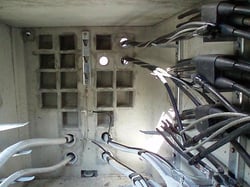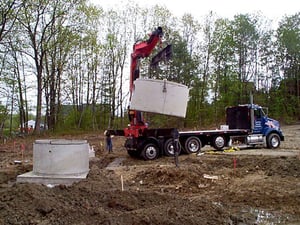Q&A: Is a construction manhole considered a permit required confined space?
![]() READER QUESTION:
READER QUESTION:
Is a new construction manhole considered a permit required confined space with the following activities being performed inside the space: overhead rigging, cutting welding, working off of six foot (6') step ladders? The task being performed is installation of new steam and condensate piping. Entry into the manhole vault is through a thirty six inch (36") round manhole opening into a vault. The vault is sixteen feet (16') deep. Entry is made by descending a twenty foot (20') extension ladder placed into the manhole opening. No other entry holes or exit holes. A 2000 cfm air mover is also in use for ventilation of the space. The area inside is congested with piping and valves being installed. Would this be considered a permit required confined space and would a rescue team be required?
ROCO TECH PANEL RESPONSE:
The answer to this question is complicated, and without actually seeing the space and without having familiarity of all the specifics surrounding the construction of the space, we cannot give you a definitive answer. However, there are several things you must consider when evaluating the situation.
 You must determine whether the space falls under General Industry (29 CFR 1910) or Construction (29 CFR 1926) requirements. If the work is considered “maintenance,” the General Industry standards are applicable. If it is considered “Construction,” the Construction standards are applicable. OSHA generally considers any work that entails “keeping equipment in its existing state, i.e. preventing its failure or decline,” as “maintenance” work covered by the General Industry standard, even if the work is construction “type” work.
You must determine whether the space falls under General Industry (29 CFR 1910) or Construction (29 CFR 1926) requirements. If the work is considered “maintenance,” the General Industry standards are applicable. If it is considered “Construction,” the Construction standards are applicable. OSHA generally considers any work that entails “keeping equipment in its existing state, i.e. preventing its failure or decline,” as “maintenance” work covered by the General Industry standard, even if the work is construction “type” work.
From your description, it appears that the installation of new steam and condensate piping is part of the initial “construction” of the vault. However, other factors could affect that determination, such as whether the new steam and condensate lines are actually part of maintenance of an already existing piece of equipment. In that case, the vault itself may be new, but the work on the lines might be maintenance.
If the General Industry standard applies, OSHA takes the position that the PRCS standard (29 CFR 1910.146) does not apply to welding, cutting, and brazing activities as long as the hazards introduced by the welding are the only hazards in the space, and the protective measures of Subpart Q - Welding, Cutting and Brazing, are adequate to prevent a hazard from developing.
The protective measures of the welding standard would be applicable to the work in this space, specifically the following paragraphs of Subpart Q: 1910.252(a)(4)(i), 1910.252(b)(4)(i) to 1910.252(b)(4)(vii), 1910.252(c)(4), 1910.252(c)(9), and 1910.252(c)(10). All other hazards must be considered when making the determination of whether the PRCS standard applies. For example, if piping or other equipment will be lowered into the vault from overhead while workers are in the space, there would be a potential physical hazard not covered by Subpart Q that might require the space to be classified as a PRCS.
 The General Industry standard for welding, cutting, and brazing activities does have certain requirements that are similar to some of the PRCS requirements.
The General Industry standard for welding, cutting, and brazing activities does have certain requirements that are similar to some of the PRCS requirements.
For example, it requires that where a welder enters a confined space through a manhole or other small opening means shall be provided for "quickly" removing him in case of an emergency. If harnesses or "safety belts" are used for this purpose, they have to be attached so that the welder's body cannot be jammed in a small exit opening. It also requires that "an attendant with a preplanned rescue procedure shall be stationed outside to observe the welder at all times and be capable of putting rescue operations into effect."
The General Industry welding standard also has certain specific ventilation requirements for spaces that are less than 10,000 cubic ft per welder, or in confined spaces where there are partitions or other obstructions that would obstruct cross ventilation. The minimum rate for such ventilation is 2,000 cfm per welder. It is important to keep in mind that the 2,000 cfm per welder is the actual air movement provided by the air mover, not the rated air movement. The ventilation must be configured to ensure that the air mover is not recirculating contaminated air back into the space. This would usually involve moving the air mover away from the entry point when there is a single opening, and ducting the air into the space. However, the use of ducting reduces the actual air movement. For example, an air mover rated at 2,000 cfm maximum will not actually be moving 2,000 cfm with 50’ of ducting having a 90 turn into the space. Each foot of ducting and each turn in the ducting reduces airflow. You stated that a 2,000 cfm air mover is being used. It is important to conduct the calculations for your ventilation configuration to determine whether you are actually moving the minimum 2,000 cfm.
Until OSHA issues its final rule on confined space safety for the construction industry (ruling is expected in 2013), there is no detailed standard at this time. However there is a construction standard for welding that has specific requirements for welding, cutting, and brazing in confined spaces (29 CFR 1926.353). The rescue requirements are the same as for the General Industry welding standard. Additionally, the Construction welding standard requires that if sufficient ventilation cannot be obtained without blocking the means of access, the employees in the confined space must be provided with airline respirators, and there must be an employee outside the space assigned to maintain communication with the employees in the space and to provide assistance in an emergency.
Obviously, to us, rescue capabilities are always at the top of the list. If the decision is made to follow the General Industry standard and consider the vault to be PRCS, then rescue capabilities and a plan need to be put in place. Depending on the conditions that exist in and around the space, rescue retrieval may be an option, such as a tripod and winch system with retrieval line attached to the entrant. In your description, however, you mention that internal elements that may hinder the ability to do external retrieval. If this is the case, then some type of internal rescue capability will be needed.
When it comes to the response time, we think Appendix F 1910.146 explains it best…
"What are the needs of the employer with regard to response time (time for the rescue service to receive notification, arrive at the scene, and set up and be ready for entry)? For example, if entry is to be made into an IDLH atmosphere, or into a space that can quickly develop an IDLH atmosphere (if ventilation fails or for other reasons), the rescue team or service would need to be standing by at the permit space. On the other hand, if the danger to entrants is restricted to mechanical hazards that would cause injuries (e.g., broken bones, abrasions) a response time of 10 or 15 minutes might be adequate."
Thank you for your question, and we hope this information has been helpful. If we may be of further service, please don’t hesitate to contact us.
NOTICE:
The information provided on our website or by our Tech Panel is a complimentary service for our readers. It is a general information resource for rescuers and is not intended as legal advice in any way. Because standards and regulations are typically performance based, and compliance with those standards and regulation is often dependent on the specific circumstances and conditions at hand, it is always important to carefully review all relevant standards and regulations, and to follow the proper protocols specific to your company or agency.




